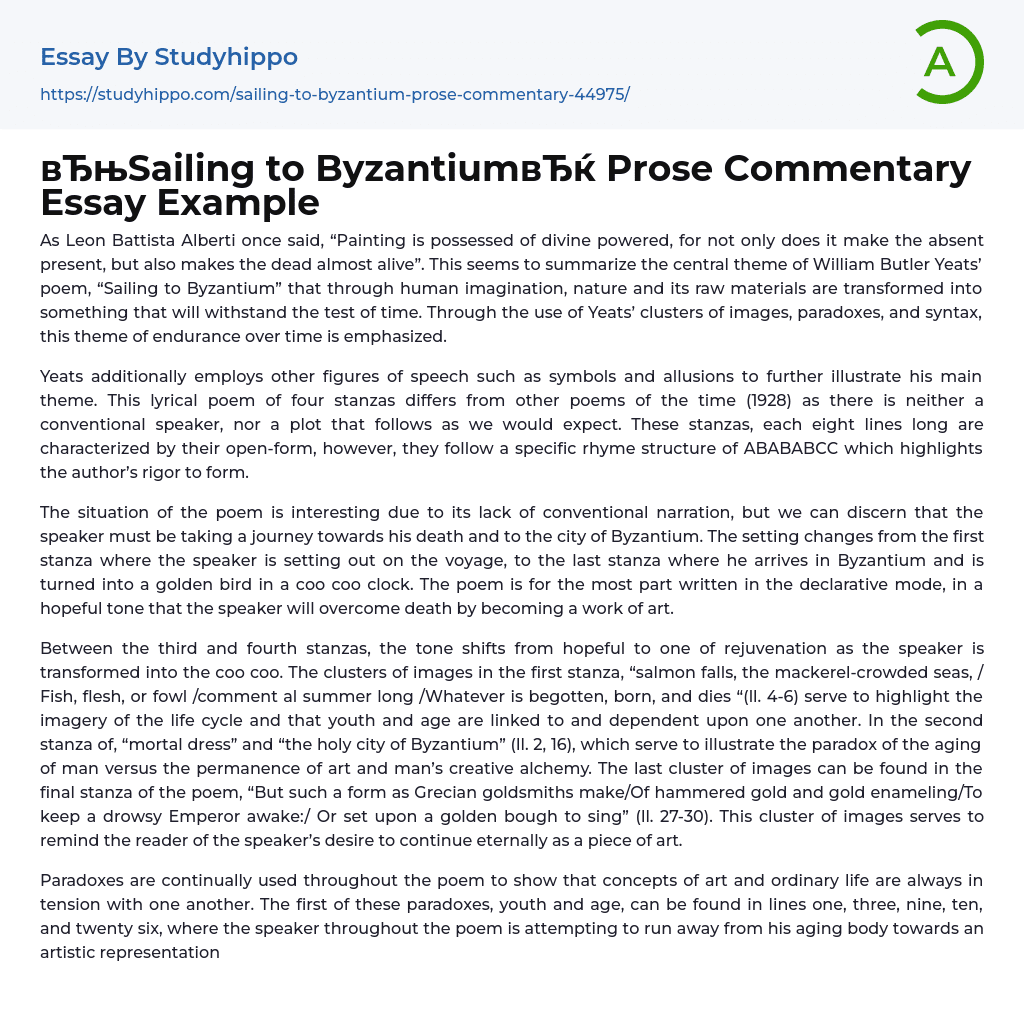Leon Battista Alberti once stated that painting possesses divine power because it not only brings the absent into the present but also almost revives the dead. This statement effectively encapsulates the main idea of William Butler Yeats' poem, "Sailing to Byzantium," which highlights how human imagination can transform nature and its raw materials into something everlasting. Yeats achieves this emphasis on endurance over time through his employment of interconnected images, paradoxes, and syntax.
Yeats also uses symbols and allusions to enhance his main theme. Unlike other poems from 1928, this lyrical poem consists of four stanzas without a traditional speaker or plot. Each stanza, containing eight lines, follows an open-form structure but maintains a rhyme scheme of ABABABCC, showcasing the author's dedication to form.
The poem'
...s situation is intriguing because it lacks traditional storytelling. However, it is clear that the speaker is embarking on a journey towards death and the city of Byzantium. The setting shifts from the initial stanza, where the speaker begins their voyage, to the final stanza, where they reach Byzantium and transform into a golden bird within a coo coo clock. The majority of the poem is written in a declarative mode and conveys a hopeful tone, suggesting that the speaker will triumph over death by becoming a masterpiece.
The tone in the third and fourth stanzas changes from hopeful to one of rejuvenation as the speaker becomes the coo coo. The images in the first stanza, such as "salmon falls, the mackerel-crowded seas, / Fish, flesh, or fowl /comment al summer long /Whatever is begotten, born, and dies," emphasize the life cycle and the interconnectedness of youth and age.
In the second stanza, there is mention of "mortal dress" and "the holy city of Byzantium," highlighting the contrast between human aging and the enduring nature of art and man's creative transformation. The last set of images in the final stanza describe a form made by Grecian goldsmiths, capturing a drowsy Emperor's attention or singing from a golden bough. These images reinforce the speaker's desire for eternal existence as a piece of art.
Throughout the poem, paradoxes are utilized to illustrate the perpetual tension between the concepts of art and everyday life. The first paradox, encompassing youth and age, emerges in several lines (1, 3, 9, 10, and 26), as the speaker strives to escape his aging physique and attain an everlasting youthful portrayal through art. Lines 12-14, 17-19, 23-24, 25-26, and 32 reveal another deliberate paradox, contrasting transcendence with life.
Although humans typically follow a life cycle, they have the ability to rise above it by utilizing their creativity and imagination to create something long-lasting. However, the realization of this creation relies on the human mind and life. These paradoxes further emphasize the idea that art and artificiality are superior to the natural world as they endure beyond death. Yeats also employs a figure of speech that connects his structure with his context. This figure of speech highlights the journey that he desires the reader to embark on alongside the speaker.
The text below highlights the use of a rhyming scheme (ABABAB) in the first six lines of each stanza, followed by a final rhyming couplet (CC) that summarizes the main idea. Each stanza presents an image and gradually leads to the central concept
the speaker wants to convey. The sentences within the ABAB structure may be split across lines to maintain the rhyme scheme or emphasize transitions between ideas.
The non-conventional nature of the plot and speaker, coupled with the open-formed writing that disregards iambic pentameter, serves to portray the unconventional nature of this poem. The speaker takes us on a journey from death to regeneration through the power of the human imagination. This journey illustrates Yeats' central concept of "the unity of being," showing that the reader could also be the speaker and highlighting the interconnectedness of all beings.
Yeats ingeniously makes the speaker and reader indistinct, allowing us to speculate about the possibilities of being the perpetual coo coo in the clock. In my perspective, Yeats has masterfully crafted this poem to evoke a multitude of imagery. As someone drawn to art and creation, the notion that our artistic pursuits provide a sense of solace aligns with the poet's intention.
- Creativity essays
- Art History essays
- Theatre essays
- Pastoral essays
- Visual Arts essays
- Postmodernism essays
- Symbolism essays
- ballet essays
- Color essays
- Modernism essays
- Mona Lisa essays
- Work of art essays
- Body Art essays
- Artist essays
- Cultural Anthropology essays
- Ethnography essays
- Aesthetics essays
- Realism essays
- Heritage essays
- Harlem Renaissance essays
- Concert Review essays
- Voice essays
- Theatre Of The Absurd essays
- Playwright essays
- Scotland essays
- Tennessee williams essays
- Design essays
- Graffiti essays
- Graphic essays
- Typography essays
- Painting essays
- Photography essays
- Sculpture essays
- Architecture essays
- Interior design essays
- Arch essays
- Area essays
- Tattoo essays
- Pablo Picasso essays
- Vincent Van Gogh essays
- Michelangelo essays
- Frida Kahlo essays
- Boo Radley essays
- Genesis essays
- Richard iii essays
- Alice in Wonderland essays
- On the road essays
- Ozymandias essays
- The Nightingale essays
- Holden Caulfield essays




